

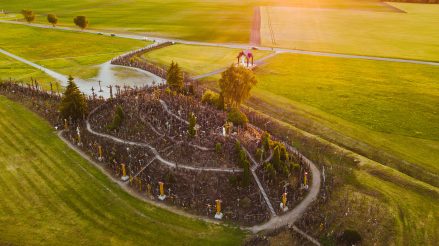
The Hill of Crosses – which is one of its kind in the world – is located 12 km north of Šiauliai. It is believed that in the Middle Ages, a wooden castle – referred to as Kula in the chronicles – stood on this hill and was destroyed by the Livonian army in 1348. Locals said that the first crosses were erected in the mid-19th century, praying for God’s grace and health, because people considered this hill to be a sacred place. Others said that the crosses were erected to commemorate those who died in the uprisings against tsarist Russia in 1831 and 1863.
During the period of Lithuanian occupation, the Hill of Crosses was a symbol of heroic resistance and belief in freedom. In the middle of the Hill of Crosses stands a sculpture of the Virgin Mary – the Mediatrix of all graces. Pope John Paul II together with Lithuanian bishops held a Mass in the chapel of the Hill of Crosses – which is also called the papal chapel – on September 2, 1993. A common motive for erecting crosses is to ask for God’s grace or to give thanks for those already received. The Hill of Crosses can also be visited at night, when the place is beautifully illuminated.

The steeple (70 meters tall) of the renaissance cathedral built in the 17th century is visible from all main roads. The diocese of Šiauliai was established there by decision of Pope John Paul II on May 8, 1997. The church became the Cathedral of St. Apostles Peter and Paul. One of the oldest sundials in Lithuania has survived on the wall of the southern facade of the cathedral. The cathedral contains two images of the Virgin Mary – next to them there are votive offerings – famous for their graces. At the cathedral’s mother of God’s chapel people say litanies or recite the rosary and in the chapel of Divine Mercy they recite the Chaplet of the Divine Mercy.
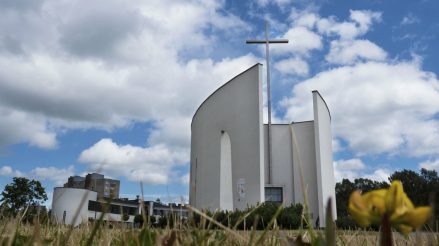
The church was built in 2009. Its building resembles two hands clasped together in prayer. Church of the Immaculate Conception of the Virgin Mary was founded in the unfinished Nuklonas culture house in October 1993. In 2006 the church moved to other premises. The church walls are adorned with the Stations of the Cross created by the sculptor A. Rimavičius (1865–1933). The talent of this woodcarver was the grace of God and the gift of the Holly Spirit.
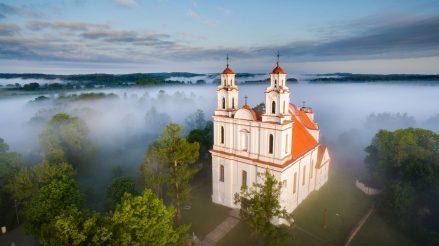
Church of St. James the Apostle in Kurtuvėnai is of the late Baroque style, built in 1792. Its towers are 50 meters tall. The church is full of mysterious and dark naves, narrow corridors, and under the church there are burial vaults with 12 crypts. Next to the right altar stands a sculpture of baby Jesus (Infant Jesus of Prague) and next to it many votive offerings, testifying to people’s gratitude for the graces received.
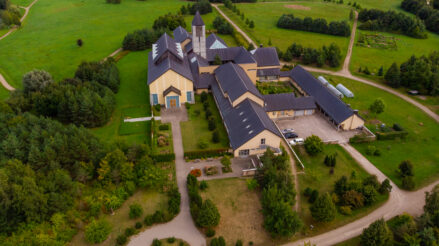
The monastery is located in the village of Palendriai. The Benedictines moved into the newly built monastery in the autumn of 2001. The church of the monastery is open for everyone, who wants to pray with the monks. Benedictines commit themselves to seek God’s love and grace by observing the vows of obedience, constancy, chastity and poverty. A fragment of the cross on which Christ was crucified and a thorn from the crown of thorns are kept in the monastery. It is believed that these relics touched the very body of Christ. Next to the monastery there is a church of the Blessed Virgin Mary of the Gates of Dawn or Blessed Virgin Mary Oratory of the Gates of Dawn. This church is not functioning, but it is one of the most interesting and beautiful examples of reinforced concrete architecture of the pre-war Lithuania. It was built by Lithuanian priest and patron Kazimieras Ambrozaitis and designed by architect Vladas Bitė from Šiauliai. Its construction began in 1935 and it was concecrated in 1938.
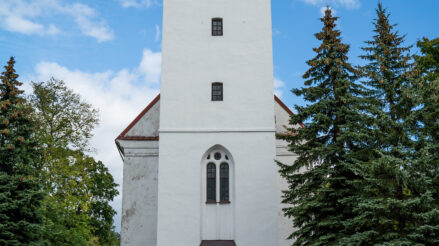
Church was built at the expense of Jurgis Gruževskis, an elder from Žemaitija in 1615. The architecture of the building is a mix of gothic and Renaissance styles. The church has one nave, one tower, a Gothic three-walled apse, and Gothic windows. One of the most important issues in Reformed doctrine is the issue of justification. The Reformed believe that man receives salvation through God’s grace. Sola Gratia – “grace alone” – is the core of the Reformed faith. However, it is not only the forgiveness of sins granted by God, but also the rebirth of the person. A man cannot earn salvation by his own efforts, without God’s justifying grace.
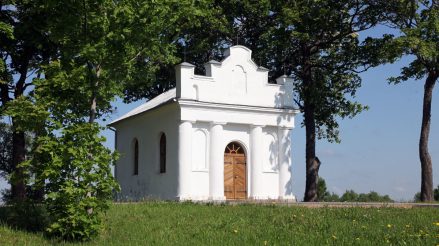
This is one of the former buildings of the Katauskiai Manor homestead. The chapel was built in 1835 and restored in 2008 to mark the 400th anniversary of the apparition of the Virgin Mary in Šiluva.
Lithuanian manor chapels were small and mostly intended for the needs of the landlord’s family. The landowners believed that God’s grace could visit their family if a chapel stood on their land.
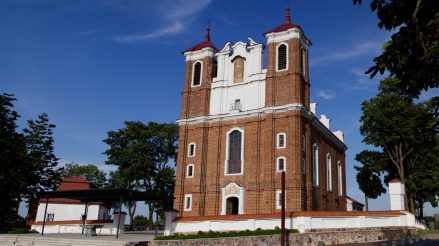
The first Catholic church in Šiluva was built in 1457. Later, the Calvinists prevailed but the apparition of the Virgin Mary in 1608 and the events that followed, when documents of the Catholic Church and a miraculous painting were found in a chest buried in the ground, helped the Catholics to reclaim the land. The icon of Our Lady of Šiluva painted in the beginning of the 17th century, and famous for its miracles, can be found in the high altar of the church. It was granted a Canonical coronation in 1786 and is still famous for its graces as evidenced by the numerous votive offerings hanging nearby. The red brick church was built in 1786. The space between the church and chapel was renovated in 2008 and a monument to John Paul II was erected.
For a long time, a wooden chapel stood at the place of the apparition of the Virgin Mary. The brick chapel was designed for the 300th anniversary of the apparition of the Virgin Mary in Šiluva (architect A. Vivulskis). The cornerstone was consecrated by priest and poet Maironis in 1912. The chapel, which is 44 meters tall, was finished in 1924. Inside it, the altar was built on the stone of the Apparition with a sculpture of the Virgin Mary above.

Tytuvėnai church of the Blessed Virgin Mary the Queen of Angels and the Bernardine monastery complex is the largest and one of the most interesting sacral architecture complexes of 17th –18th centuries, characterized by a variety of architectural styles. Tytuvėnai church contains a miraculous painting of Madonna and Child and there is a unique chapel of the Holy Stairs in the churchyard. The Madonna and Child painting famous for its graces was painted in 1720s. It is the ornament of the whole church. The child is blessing with his right hand and the Virgin Mary’s right hand is directed at Him – the source of graces.
The monastery complex was finally formed in 1772 – 1780. A closed rectangular courtyard with arcaded galleries for Stations of the Cross was built next to the church. The church has a relic of Pope John Paul II – a drop of blood placed in a special capsule.
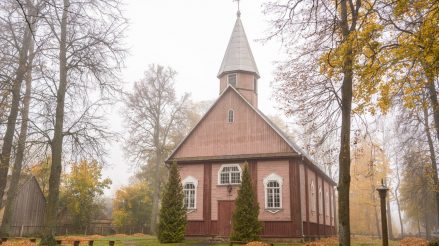
The first church in Basilionai was built in 1749. Until 1836, there was a monastery of Basilian monks here. The current wooden church was built in 1933. The building is an example of folk architecture with rich interior. The church is famous for the sculpture of St. John of Nepomuk, which was stolen, but thanks to the grace of God returned to the church.
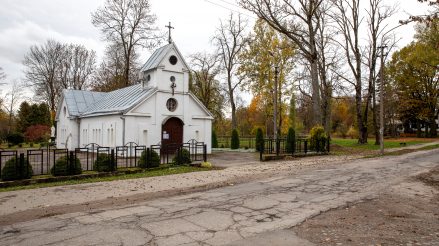
The church was built as the chapel of Karpis Manor in 1800 and received the status of a church in 1936. Around 1956 the church was closed, its property looted. It was turned into a warehouse. By God’s grace, the church was returned to the faithful in 1989, and in 1991 it was consecrated again.

The Hill of Crosses – which is one of its kind in the world – is located 12 km north of Šiauliai. It is believed that in the Middle Ages, a wooden castle – referred to as Kula in the chronicles – stood on this hill and was destroyed by the Livonian army in 1348. Locals said that the first crosses were erected in the mid-19th century, praying for God’s grace and health, because people considered this hill to be a sacred place. Others said that the crosses were erected to commemorate those who died in the uprisings against tsarist Russia in 1831 and 1863.
During the period of Lithuanian occupation, the Hill of Crosses was a symbol of heroic resistance and belief in freedom. In the middle of the Hill of Crosses stands a sculpture of the Virgin Mary – the Mediatrix of all graces. Pope John Paul II together with Lithuanian bishops held a Mass in the chapel of the Hill of Crosses – which is also called the papal chapel – on September 2, 1993. A common motive for erecting crosses is to ask for God’s grace or to give thanks for those already received. The Hill of Crosses can also be visited at night, when the place is beautifully illuminated.
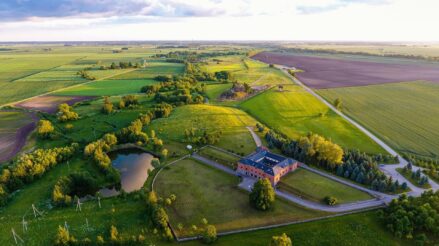
When visiting the Franciscan monastery of Mount La Verna in the autumn of 1993, Pope John Paul II urged the Franciscan brothers to build a monastery near the Hill of Crosses and they responded to the Pope’s call. And so Franciscan friars from the province of Tuscany started the construction of the building that stands 300 meters away from the Hill of Crosses. It was solemnly consecrated on July 8, 2000. In their prayers, the Franciscan friars often ask for God’s grace and renewal in the light of the Gospel.

The steeple (70 meters tall) of the renaissance cathedral built in the 17th century is visible from all main roads. The diocese of Šiauliai was established there by decision of Pope John Paul II on May 8, 1997. The church became the Cathedral of St. Apostles Peter and Paul. One of the oldest sundials in Lithuania has survived on the wall of the southern facade of the cathedral. The cathedral contains two images of the Virgin Mary – next to them there are votive offerings – famous for their graces. At the cathedral’s mother of God’s chapel people say litanies or recite the rosary and in the chapel of Divine Mercy they recite the Chaplet of the Divine Mercy.
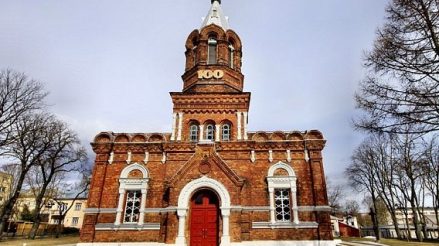
The neo-Byzantine style church in Šiauliai was built in 1908 at the expense of the Russian tsarist government. The church was consecrated and named after Saint George. In 1915, after the tsarist army withdrew from Lithuania, the church of the Russian army was closed and not used for some time. During World War I, the Germans turned the church into a warehouse. After the war, it was handed over to the spiritual needs of the 3rd Regiment of the Lithuanian Army. The church was blessed and given the name of St. George the Martyr. The nave on the left side of the church contains a sculpture of Madonna and Child, which was famous for its graces.
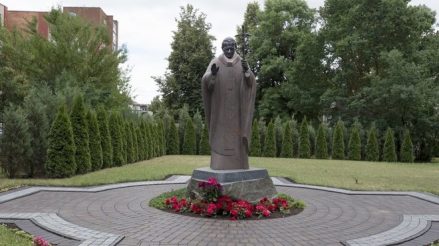
The church is located in the city center, right next to Šiauliai Boulevard. During his visit to Lithuania on September 7, 1993, Pope John Paul II blessed the church as well as the future Jesuit school. The Jesuits follow the motto, “Everything for the greater glory of God.” Often, devoting themselves to the grace of God, they would undertake various difficult tasks – missions or educational activities. The Jesuit monastery in Šiauliai was established in 1930 under the care of priest Benediktas Andruška (the first rector). The public oratory was built in 1935. In 1949, the church and monastery of St. Ignatius were closed. A warehouse and later a sports hall was installed in the church. It was returned to the congregation in 1990.
In commemoration of the 20th anniversary of Pope John Paul II’s visit to Lithuania, a monument was erected in the church yard. The path from the boulevard to the statue of the pope was named after Pope John Paul II.
When Pope John Paul II was kneeling in the church of St. Ignatius of Loyola, his cassock was smeared with paint, and a red stain was noticed on the sculpture erected near the church, exactly where the pope’s cassock was stained. The people of Šiauliai call this event a miracle.
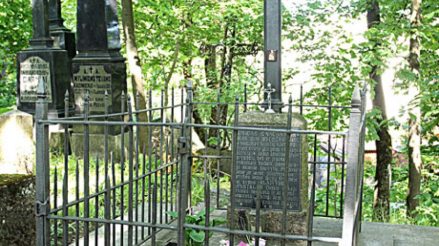
Priest Ignacas Štachas (born on October 9, 1797, in Varniai, died on October 28, 1854, in Šiauliai) is one of the sobriety promotion pioneers in Lithuania. It is believed that people who pray at the grave of priest I. Štachas, receive various graces. In the past, high school and university students visited here before the exams. Desperate people and sinners who wanted to return to the path of righteousness used to walk on their knees around the grave. The priest is buried in the Old Cemetery on the slope of St. John’s Hill. Other notable people are also buried in the cemetery. The case for the beatification of priest Ignacas Štachas was started in 2016.

The church was built in 2009. Its building resembles two hands clasped together in prayer. Church of the Immaculate Conception of the Virgin Mary was founded in the unfinished Nuklonas culture house in October 1993. In 2006 the church moved to other premises. The church walls are adorned with the Stations of the Cross created by the sculptor A. Rimavičius (1865–1933). The talent of this woodcarver was the grace of God and the gift of the Holly Spirit.
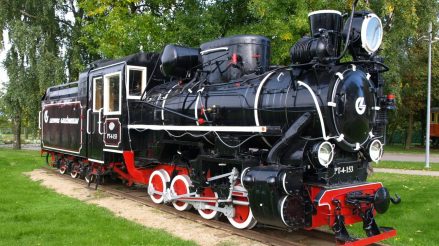
The Railway Museum of Šiauliai is a departmental museum that collects, stores, restores and exhibits artifacts related to the railway history of the Šiauliai Region. The museum was founded on September 4, 1971, commemorating the 100th anniversary of the railway of Šiauliai.
Lunch break: 12 p.m. – 12:45 p.m.

The Angel Museum opened its doors to Šiauliai residents and guests on September 6, 2014. Rytis Milkintas’ collection of angel sculptures became the basis of the museum collection. He started collecting angels in his early childhood. The first exhibit appeared when he was 7 years old. A porcelain angel was given to him by his grandfather.
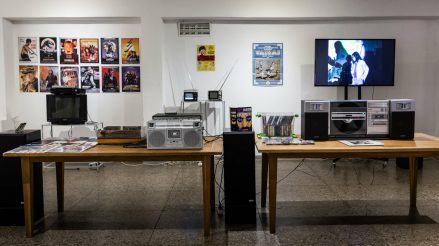
Šiauliai Art Gallery has been one of the most important fine art centres in Northern Lithuania since 1992. The gallery hosts exhibitions by local, national and foreign artists. Since its establishment, the Šiauliai Art Gallery has been creating the city’s cultural identity and signifying the city’s creative powers by promoting artistic innovations. The gallery initiates various fine art projects, creates opportunities for young creators to realize their boldest ideas, and organizes anthological, thematic and solo exhibitions.
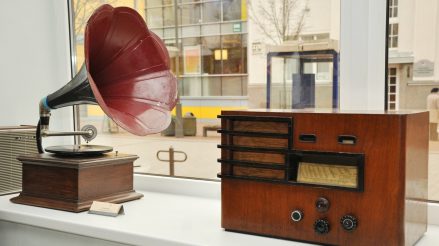
Radio and Television Museum offers an exhibition on the history of radio receivers and TV sets. Here, visitors are invited to explore, discover and maybe even see various technical devices for the first time. The exposition shows the most valuable exhibits that date from the end of the 19th century to the present day. They reveal the development of music boxes, gramophones, turntables, radio receivers, TV sets and other telecommunication devices and help to know and understand their capabilities and working principles. The exhibition features working television receivers made in different periods, mechanical gramophones, electrophones, and tape recorders, which you can play. In addition to that, visitors can look for radio stations using the old radio receivers, test the telegraph machine and send an SOS signal using Morse code. Every year, the exhibition space of the museum presents an exhibition on a relevant topic for that year.
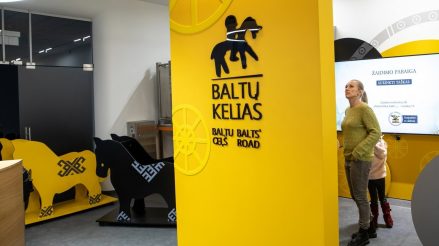
It is the first interactive centre for the promotion of Baltic culture in Lithuania and Latvia. The main goal of this centre is to encourage travel and learning about the tangible and intangible, cultural and natural heritage of the Balts. Special routes were created for traveling through Baltic lands, a tourism guide, a website www.baltukelias.lt, and now also a unique space that will help you to get acquainted with the past and present of Baltic culture.
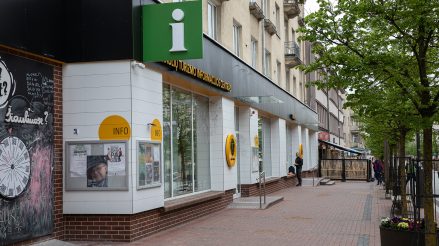
The center provides tourists and guests of Šiauliai with information about tourism services, places of interest and objects in Šiauliai, and the history of the city; it organizes tours, city events and carries out various communication projects related to the strengthening of the image of Šiauliai, promoting the identity of local residents and increasing tourist flows.
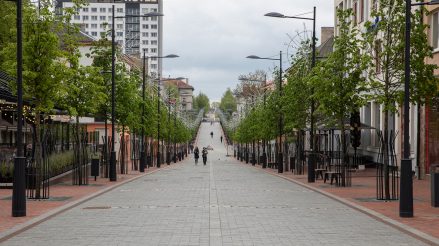
Vilniaus Street, like Tilžės Street, was built in the 18th century. It is a historical key that leads from east to west or vice versa, just like Tilžės street – from south to north.
In the 20th century, during the reconstruction and development of the city that was severely damaged during the First World War, Vilniaus Street was full of expressive modernist buildings. Many of the 2 – 4 storey brick buildings on Vilniaus Street (from Tilžės Street to Didždvaris Gymnasium) have survived to this day.

Photography Museum is the only specialized museum of the history, art and technique of photography in Lithuania. It is an important multifunctional photography centre that stores and represents a significant collection of almost 150,000 exhibits and artifacts, Lithuanian visual heritage objects, photographic techniques and equipment, prints and documents.
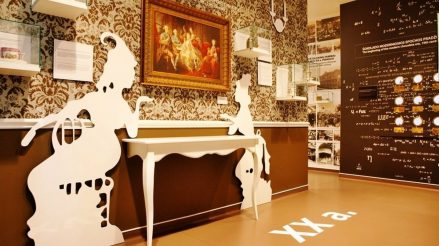
Even Brussels, famous for its chocolate industry, might envy such a museum.
Rūta Candy factory, which has been tempting passers-by with the sweet smells of chocolate, caramel, roasted nuts and boiled berry preserves for almost a century, opened the doors of its old building to visitors in 2012.
It is here, in the old factory building, that the Rūta Chocolate Museum is located.
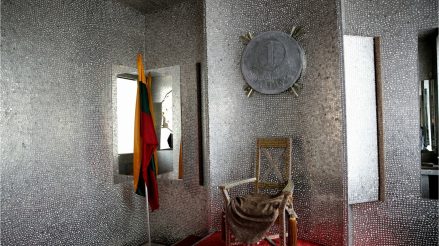
As the introduction of the euro was approaching, the idea of a monument to the Lithuanian currency – the Cent Room – was born, which artists and representatives of non-governmental organizations undertook to implement.
The walls and ceiling of the room are covered with cents. There is also a symbolic throne, above which, hangs a large one litas coin and a map of Lithuania. The entire area of the map is covered with white cents, the settlements are marked with 10, 20 and 50 cent coins, and the big cities are marked with metal litas.
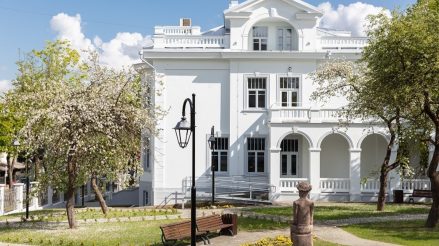
Venclauskiai House-Museum is a multifunctional centre for learning about history and culture; it is a non-traditional space for communication and leisure in Šiauliai. It is a prominent architectural object of interwar period modernism (architect Karolis Reisonas) and a unique and one of the most characteristic examples of hand-painted private interior decors of the early 20th century. The cultural heritage object, which was restored in 2019, features historical exhibitions, events and educational workshops; it offers creative workshops, and provides an open reading room.
A museum exposition is presented to the public in the Venclauskiai House, which introduces the visitors to the early 20th century history of Šiauliai and reveals the place that the exceptional, patriotic, public spirited and active large family of Stanislava and Kazimieras Venclauskiai had in it.
In 1991, Gražbylė and Danutė Venclauskaitė gifted the house to Aušra Museum of Šiauliai with condition that the building will always belong to the public and it will be turned into a museum. Their parents’ house is open to visitors again and is waiting for everyone who wants to know and create the history of Šiauliai.

It is the only specialized museum in Lithuania dedicated to the history of the bicycle. Founded almost four decades ago, the museum combines traditional exhibitions with the latest technologies. Every visitor here becomes an active participant who can get acquainted with the history of the bicycle and experience the possibilities and entertainment provided by this vehicle.
On the first floor of the museum, both adults and children can enjoy competitions riding a modern and an antique bicycle.
The old wooden bicycle is built according to drawings that are almost five centuries old. In the exhibition on the third floor, you can try road cycling, and on the second floor you can try a non-traditional sports vehicle – velomobile.
Those who visit the museum will learn not only about the development of one of the oldest transport, sports and eco-friendly vehicles, but will also get to know the cyclists who made Lithuania famous in the world with their tours. There is a rest area and a special information space installed for the convenience of the museum visitors.
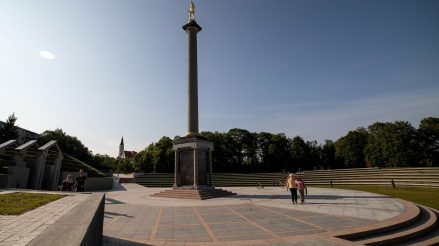
The main idea of the square is to give a sense to the three most important symbols of the city of Šiauliai: the sun, the Battle of Saule that took place in Šiauliai area in 1236, the archer associated with the origin of the city’s name, and the tirelessly passing time.
The architectural ensemble (architects: Algimantas Černiauskas, Remigijus Jurėla, Algis Vyšniūnas; sculptor: Stanislovas Kuzma 1984 – 1986) consists of an amphitheatre-shaped square and an obelisk rising to a height of 18 m, crowned by a gilded sculpture of a running archer. The obelisk with the figure of an archer becomes a gnomon on a sunny day.
The sun’s shadow moving across the dial with metal numerals cast in the square (12, 3 and 6) shows local time. The numerals mark the year that the city of Šiauliai was founded: 1236. Raising the bow up and having already shot an arrow, the Archer glimmers after catching even the tiniest ray of sun. The sundial square has been renovated in 2018. The restoration of the Archer required 1,900 sheets of the several microns thick gold foil.
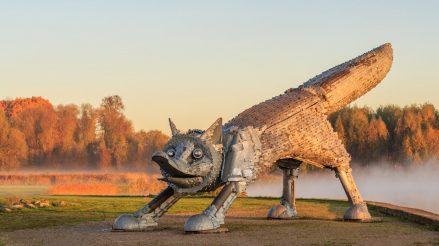
The Lithuanian Book of Records states that this is the largest animal sculpture. It weighs almost 7 tons, its length is about 15 meters, height 6.6 meters, and its width is 4.15 meters.
The steel heart of the Iron Fox (1.20 m. high and 0.90 m. wide) contains a capsule with words engraved on a copper plate for our future children. This is the work of Vilius Puronas – a designer from Šiauliai – to commemorate the millennium of the mention of the name of Lithuania.

Žuvininkai Mound (Salduvė Hill) with the historical settlement located in the village of Žuvininkai is included in the Lithuanian Register of Cultural Property. In the context of Lithuanian history, the significance of this object is exceptional, because the castle that stood here was the main defense center of the northern lands of Lithuania.
The mound offers a great panorama or the city.

The chapel of the Hill of Crosses also called the chapel of the Pope, is located at the Hill of Crosses, in the village of Jurgaičiai, Šiauliai district. It was built for the visit of Pope John Paul II in 1993. It is a cultural heritage object that was included into the Lithuanian Register of Cultural Property (unique code 36136). It is customary in the world that the place of the Pope’s prayer is dismantled, but the chapel of the Hill of Crosses is probably the only place of Pope’s prayer that remained and even became an object of cultural heritage.
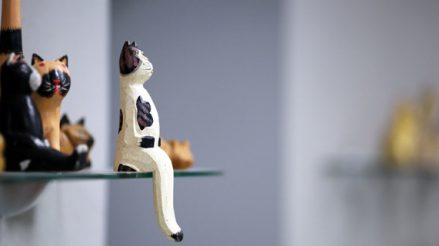
The visitors of Vanda Kavaliauskienė’s Cat Museum – founded in 1990 by her and named after her – are welcomed by cat exhibits and a mischievous cat Perlas referred to as the “head of the museum.” The three halls of the museum contain cats, cats and… more cats. The exhibits come not only from different parts of Lithuania but also from across the world including the United Kingdom, Australia, United States of America, France, Russia, Taiwan, Switzerland, Portugal and other countries.

The tourism center is located near the Hill of Crosses. The center provides information about objects, places, educational trails, and tourism services in Šiauliai district.
Here you will find various souvenirs, amber products, snacks, coffee, and water.

Chaimas Frenkelis’ villa with a park and a fountain is a unique spot in Šiauliai. It is one of a few secession buildings in Lithuania, built in the early 20th century. Its facade combines elements of various architectural styles and authentic interior fascinates with its surviving wooden trim and ornate moldings. The expositions in the villa present the culture of the estates of the Lithuanian provinces, the culture of Šiauliai during the interwar period and the Jewish heritage. The villa hosts exhibitions, concerts, film and music festivals as well as other events. A modern-style park is open to visitors. In 2018, on the occasion of the centenary of the restoration of Lithuanian statehood, a rosarium of a thousand roses was planted in it. The park has free parking for cars and buses.

The church was built in 2009. Its building resembles two hands clasped together in prayer. Church of the Immaculate Conception of the Virgin Mary was founded in the unfinished Nuklonas culture house in October 1993. In 2006 the church moved to other premises. The church walls are adorned with the Stations of the Cross created by the sculptor A. Rimavičius (1865–1933). The talent of this woodcarver was the grace of God and the gift of the Holly Spirit.
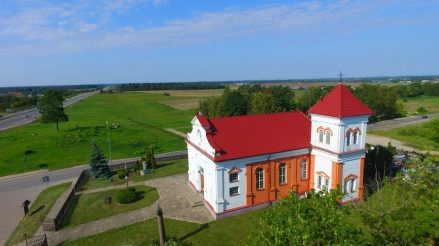
Around 1764 a wooden chapel was built in Aukštelkė estate. A brick chapel built under the order of A. Radavičius in 1885 belonged to the parish of Šiauliai and was served by the priests of Šiauliai. The chapel was destroyed in 1915, during World War I. Priest Vincentas Jarulaitis (1859 – 1939, buried in Aukštelkė) rebuilt the chapel in 1932. After World War II, people started calling the chapel church and it was renovated in 1967. The front facade of the church is decorated with angel sculptures. Angels often convey God’s messages to people.
The angel who appeared to the Virgin Mary had said to her, “Greetings, favored one! The Lord is with you.”

Church of St. James the Apostle in Kurtuvėnai is of the late Baroque style, built in 1792. Its towers are 50 meters tall. The church is full of mysterious and dark naves, narrow corridors, and under the church there are burial vaults with 12 crypts. Next to the right altar stands a sculpture of baby Jesus (Infant Jesus of Prague) and next to it many votive offerings, testifying to people’s gratitude for the graces received.

The visitor center of the Kurtuvėnai Regional Park has been established in the restored wheelhouse of Kurtuvėnai Manor. In its Landscape Diversity exhibition, while walking around “giants” the visitors will get to know the values of the Kurtuvėnai Regional Park, the concept of the landscape, its structure, change, and preservation. The visitor center provides information about the areas visited in the regional park, educational trails, and tourism services.
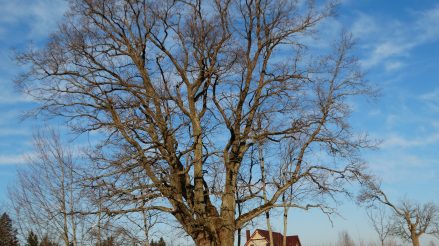
The oak of exceptional dimensions and appearance, growing in the Šiauliai district, in the village of Visgirdai (Bubiai eldership) is a state-protected botanical natural heritage object. The multi-stemmed oak grows on a stone embankment. It stretches from Šiauliai to Bubiai, about 10 km through Verduliai, Gegužiai, Šlepkai and Meškiai villages and the settlement of Aukštelkė.

One of the strongest castles in the Šiauliai region stood here in the 13th century. It played an important role in the fight against crusaders. The Dubysa Castle (German: Dobitzen) is repeatedly mentioned in German chronicles. The castle was made of wood, surrounded by a 5-6-meter-high wall of wooden logs reinforced with stones. It is believed that the garrison of the castle may have consisted of 50 – 70 armed men. In the summer of 1236, the Livonian order defeated in the Battle of Saule tried unsuccessfully to capture Dubysa Castle. The stubborn resistance of the garrison of the castle helped Bulioniai dukes to catch up with and completely defeat the enemies at the Mūša River. Dubysa Castle was burned by a large army of the Order in 1348. The castle was quickly rebuilt but burned down again during an attack in 1358. Livonian chronicles record that during this storming of the castle one hundred of its defenders and two brothers of the Order were killed.
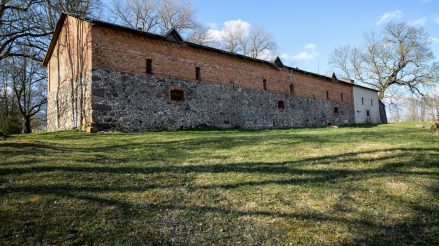
Bubiai began to form as a manor at the end of 18th century when the Russian czarina Catherine the Great gifted Bubiai to her favorite Platon Zubov. After his death, the estate was inherited by his brother Dmitry Zubov and later his son Nikolay. The construction of Dubysa-Venta canal began in 1825. The construction of this complex’s hydrotechnical facility determined the economic growth of Bubiai. A small village grew into an economic center of the manor (folwark), a post road to Šiauliai was built as well as a bridge over Dubysa with an almost finished winter port. Unfortunately, the uprising of 1831 thwarted the completion of construction works. The rebels in Bubiai gathered their forces for the assault on Šiauliai. N. Zubov’s son Dmitry opened an elementary school, where children were taught in Lithuanian, and an orphanage with his own funds. During the reign of D. Zubov, Bubiai Manor shifted towards animal husbandry; livestock farming and dairy schools were established. The manor also had a sawmill, a brickyard, and a distillery. Bubiai Manor was an important cultural and economic center from the end of the 19th century until 1940.
Along with the palace built in 1908, the estate complex also contains a park, stables built in the 19th century and renovated in the 20th century, a granary, a gardener’s house, a guard house, a school, a teacher’s house, three farm-hand buildings, a barn, a silo, two hay barracks, a distillery, a spirit storage, an outbuilding, a house, a sawmill and the machinery in it.
One of the manor buildings was recently turned into a hotel.

It is an old, unusual-looking tree growing on the border of the villages of Girnikai and Pociškė. People say that the pine was haunted. A wayside shrine was placed in the tree. Its height is 12.5 m, the circumference is 3.3 m, and the diameter is 1 m.
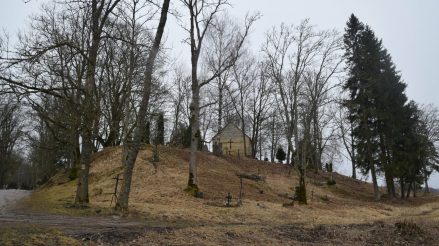
From the 2nd millennium BC to the 14th century, the mound must have been the largest and most important settlement in the surrounding area. The community that developed there one and a half thousand years ago, settled on the larger adjacent hill as a village of farmers. The communal village that existed for about a thousand years gradually turned into a noble village, and the latter into a manor. The mound has a stone with a plate-shaped bowl.
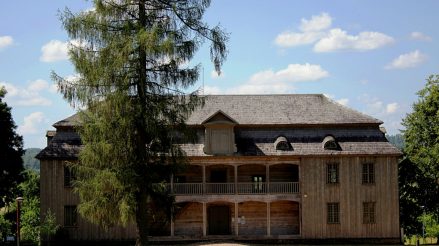
This is one of the oldest manor estates in Lithuania, known since the 15th century. The manor at the crossroad of Žemaitija was ruled by famous Lithuanian noble families – Kęsgailos, Karpiai, Skaševskiai, Nagurskiai, Tiškevičiai, Pliateriai-Zyberk – at different times. The authentically restored manor homestead complex consists of a park with ponds, servants’ house, barns, blacksmith’s workshops and more. The complex is complemented by the nearby Kurtuvėnai mound, an 18th century brick church of St. Jacob the Apostle with the old parish buildings. The most valuable building is a unique, wooden 18th century granary. It has a gallery where exhibitions are held. Kurtuvėnai campsite operates in the manor garden, and there are volleyball and croquet courts as well as children’s playgrounds. Those, who wish to get acquainted with the manor homestead can take a 1 km educational trail equipped with information stands.
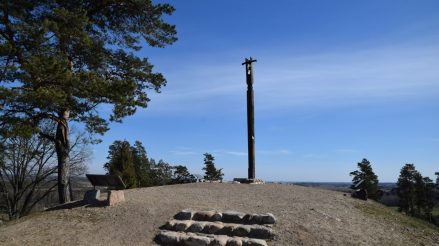
The holly hill of Girnikai (Šikštas Hill) is the tallest hill in Šiauliai district (183.4 m). It offers a panoramic view of the regional park, Žemaitija uplands, Šiauliai, Kuršėnai, and Kurtuvėnai. The legend says that it used to be a holy place. There are stories about Kurtuovė – the mother of giants buried in the hill, a church that was swallowed by the hill and a stone on top of it, on which the holy fire burned. Every year on September 22, during the commemoration of the Battle of Saule that took place in 1236, the fire of Baltic unity is lit on the holly hill of Girnikai. The first monument dedicated to the abolition of the ban on the Lithuanian press was erected on the top of the hill in 1905. On the northern slope of the hill there is a cemetery for soldiers of the First World War.
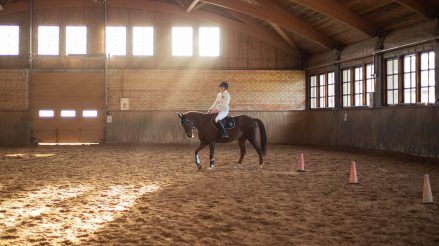
The Living Horse Museum of Kurtuvėnai is located in the stables of Kurtuvėnai Manor. Here you can get to know the horses, the unique life of the museum, where about 30 horses – each of them with their own story – live. Those, who want to get to know the life of the museum and its inhabitants are offered a tour of the Living Horse Museum. And for those who want to get to know them more closely can join educational programs Horse Friendship and Horseshoe of Happiness.
Here, in any weather, you can stop by to ride horses or ponies, join a horseback riding school, go on a horseback ride around the beautiful surroundings of the Kurtuvėnai Regional Park, as well as have a ride in a brake or an authentic stagecoach.

Two interesting pines in the village of Dirvonai received state protection. People consider them sacred. A cross is attached to one, and a wayside shrine on the other. When there was no church in Bazilionai, residents of the village of Padegliai used to go to Kurtuvenai to pray. Pilgrims used to stop at Dirvonai to pray, greeting the Kurtuvėnai church from afar. The old residents of the village of Sodeliukai had heard from their parents that the pine trees were marked in 1912 – 1914. All kinds of incredible stories are told about it. Here is one of them.
This old man named Liaudins had died in the village of Dirvonai. When going to church, after dark, people kept meeting the deceased dressed in black by the pine tree. Suspecting that the devil was leading the deceased, the villagers nailed a cross to the pine tree and the departed walked no more.
It is said that after the war, one Soviet collaborator shot at the crosses and later hanged himself. His son also died under tragic circumstances.
The shrine’s story is not as grisly. Some man, who came from Piktuižiai, simply had a dream of the Virgin Mary, who asked him to build a wayside shrine. The man made a beautifully carved, green-painted shrine with a figure of Virgin Mary. It hung on a tree for a long while before it perished during the war. Soon, another one appeared in place of the old one, but it too was destroyed by someone. Now hangs the fourth and a relatively new shrine.
Residents of Dirvonai and Sodeliukai still come to the sacred pines to pray, they bring flowers and light candles during religious holidays. In 2004, the two pines of Dirvonai have been declared a protected botanical natural heritage object by the municipality.
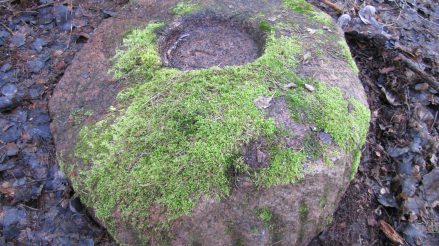
Pašvinė stone with a plate-shaped bowl was included into the Register of Cultural Property in 2017. This is a boulder carved by humans. It is a pink large-grain granite in the shape of an irregular cylinder, about 1.1 m in diameter and up to 0.45 in height. On the sides, the 3 – 5 cm wide and 2 cm deep grooves have been sculpted throughout the visible height of the stone. A bowl with a flat bottom is carved out in the middle of the top of the flat surface, 36 –37 cm in diameter and 7 – 8 cm in depth. Stones with flat-bottomed bowls are classified as ceremonial stones of Curonians (a Baltic tribe).

Žaliūkiai Village miller’s farmstead is an oasis of ethnic culture, traditional customs and entertainment, surrounded by a modern city. Upon their arrival in Šiauliai, the visitors can see the restored windmill of Žaliūkiai with an authentic grain grinding equipment and the restored miller’s cabin. The restored windmill is the only surviving construction of wooden architecture and an object of industrial heritage from the second part of the 19th century as well as the first museum of grain processing history in Lithuania.
Throughout the year, everyday life of the miller’s family can be observed in the homestead. The grain is milled, the bread is baked, and educational activities and tours are conducted during which the miller himself introduces the visitors to the grain processing and unique equipment of the mill.

Church of St. James the Apostle in Kurtuvėnai is of the late Baroque style, built in 1792. Its towers are 50 meters tall. The church is full of mysterious and dark naves, narrow corridors, and under the church there are burial vaults with 12 crypts. Next to the right altar stands a sculpture of baby Jesus (Infant Jesus of Prague) and next to it many votive offerings, testifying to people’s gratitude for the graces received.

The monastery is located in the village of Palendriai. The Benedictines moved into the newly built monastery in the autumn of 2001. The church of the monastery is open for everyone, who wants to pray with the monks. Benedictines commit themselves to seek God’s love and grace by observing the vows of obedience, constancy, chastity and poverty. A fragment of the cross on which Christ was crucified and a thorn from the crown of thorns are kept in the monastery. It is believed that these relics touched the very body of Christ. Next to the monastery there is a church of the Blessed Virgin Mary of the Gates of Dawn or Blessed Virgin Mary Oratory of the Gates of Dawn. This church is not functioning, but it is one of the most interesting and beautiful examples of reinforced concrete architecture of the pre-war Lithuania. It was built by Lithuanian priest and patron Kazimieras Ambrozaitis and designed by architect Vladas Bitė from Šiauliai. Its construction began in 1935 and it was concecrated in 1938.

The church in Verpena was built in 1775 at the initiative of Count Valavičius. In the years 1901 – 1908, Kelmė Catholics also prayed there because the church in Kelmė was still under construction. The tradition of the procession traveling 3,5 kilometers to Verpena during the church festival of St. Anne remained to this day. The wooden church of Verpena is characteristic of folk architecture. It is of a rectangular plan, has one tower and one nave. Its shape resembles the brick Evangelical Reformed Church in Kelmė. The cross of the Crucified Jesus in the central altar of the church is leaning forward as if bringing the faithful closer to His suffering, His holiness and to the possibility of experiencing His graces.

The first church in Kelmė was built in 1416 by Grand Duke Vytautas of Lithuania. Later, the church in Kelmė was rebuilt several times. In 1901 the foundations of the future church were consecrated, and its construction was completed in 1908. The church is neo-Gothic with a Latin cross plan, a three-walled apse and a tall tower of the facade. There is a turret at the intersection of the roofs. This church has exceptional acoustics that invite you to reflect on God’s love and prepare to receive God’s graces.

Church was built at the expense of Jurgis Gruževskis, an elder from Žemaitija in 1615. The architecture of the building is a mix of gothic and Renaissance styles. The church has one nave, one tower, a Gothic three-walled apse, and Gothic windows. One of the most important issues in Reformed doctrine is the issue of justification. The Reformed believe that man receives salvation through God’s grace. Sola Gratia – “grace alone” – is the core of the Reformed faith. However, it is not only the forgiveness of sins granted by God, but also the rebirth of the person. A man cannot earn salvation by his own efforts, without God’s justifying grace.
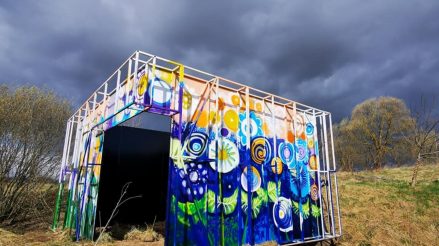
The outdoor gallery was established by a local artist Andrius Seselskas and his family on the outskirts of Kelmė. It is the only such gallery in Lithuania with a stream inside, so you can view the paintings while standing on the bridge.
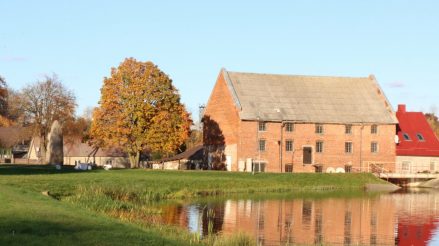
The water mill was built in the end of the 19th century. The Kražantė dam was rebuilt 17 years ago, and a pedestrian bridge and a path were built here. The water level has been raised by about 3 m, but at medium and lower water levels, migrating fish cannot overcome this height and enter the river basin. Therefore, in 2014, a fishway for migrating fish has been installed in the Kelmė dam. The Kražantė river pond covers an area of 5 ha.

The Kelmė Manor ensemble is a cultural heritage object protected by the state and is valued as a rare surviving baroque-style Lithuanian provincial manor house. 9 buildings from the manor estate have survived to this day. Kelmė Manor is the place where the uprising of 1831 against Tsarist Russia first started in Lithuania. The first museum of Kelmė was opened in the house of the Riflemen’s Union in 1936. In Kelmė Manor – museum – visitors are introduced to the only exhibition of native American culture in Lithuania. Tourists are entertained with Native American games and quizzes; they are treated to Iroquois cakes and mate with honey. Visitors can get adventurous by shooting arrows at the bison silhouettes.
Visiting at other hours on Saturdays and Sundays available by prior arrangement.

Mečislovas Ežerskis, who lives in Kelmė, has carved over 3,700 sticks. In 2009, Mečislovas’ sticks were certified and recognized as national heritage products. Mečislovas Ežerskis says that a stick can be carved from different types of wood. One can use an unusually twisted hazel, linden, bird cherry, or a birch, rowan or aspen branch. However, you cannot bend spruce or oak. Each stick, according to the master, is unique and you will not make or find another one like it. The longest stick made by Mečislovas is two meters long, and the shortest one is fifteen centimeters. Currently, the museum exhibits 1,200 sticks.
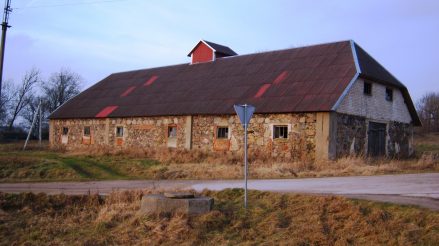
Verpena Manor homestead still stands in the village of Verpena, Kelmė district, about 2 km north of Kelmė, near the road 2103 Verpena – Šalteniai – Ramučiai. Some of the manor buildings have remained including the central palace, a residential building, granary and a barn.
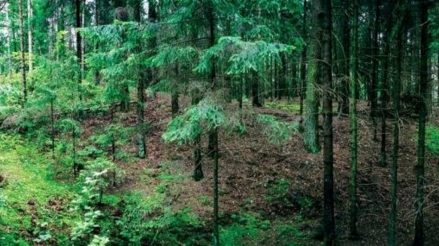
Puikiškė Mound is located in Kelmė district municipality, near the village of Puikiškė. The mound is located on a promontory. The site is oval, elongated, stretching from the north to the south, 50×15 m in size. On its northern edge there was a rampart, which has now been completely demolished, behind which there is a 17 m wide, 1 m deep ditch to the north, separating the mound from the part of the hill that was not used for it. The slopes are steep, 12 m high. The mound dates back to the 1st millennium.
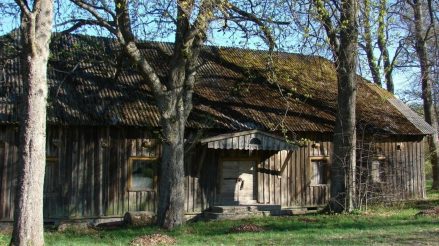
The first information about Šilo Pavėžupis Manor dates back to the 16th century. I. Sprogis mentions Šilas Manor located next to Vėžupis stream in his geographical dictionary of 1575. Later, this area was called by both names. In the middle of the 18th century, Petras Putvinskis married the noble lady Radavičiūtė of Šilo Pavėžupis. Putvinskis managed the manor until nationalization. In 1944, Šilo Pavėžupis found itself on the front line. Many farm buildings were burnt. Putvinskis’ house was destroyed by the fire that erupted on January 5, 1983. A stone with a little sun given by the famous Paberžė monk Father Stanislovas was built in its place. A wooden granary that belonged to the manor still stands.
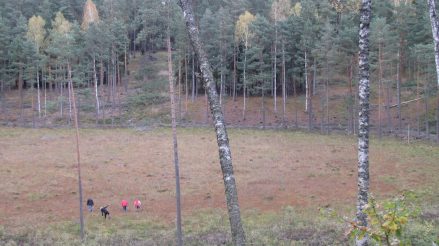
The Pustlaukis pit was dug out by a steep and swirling stream of water falling from the edge of the glacier in the late ice age. The ice floe left in the pit further accentuated the shape of the relief and when it melted it turned into a rather deep lake. Relatively recently, this body of water turned into a swamp, and there are still a few small openings. The water layer under the raised bog covered in vegetation is from 4 to 6 meters.
Palynological (pollen) studies carried out in Pustlaukis pit showed how the climate and vegetation changed in this area. 11 – 12 thousand years ago, pines and birches prevailed here and grass grew abundantly; 9 – 10 thousand years ago, forests spread, and various types of grass disappeared; 8 – 9 thousand years ago aquatic vegetation was dominant there; 5 – 8 thousand years ago a sudden increase in broad-leaved trees (oaks, lindens, elms) was observed; 3 – 5 thousand years ago, dense spruce forests have formed and during the last climate cycle, which has been lasting for more than 3 thousand years, the number of pines has increased again in the environment of the Pustlaukis pit.
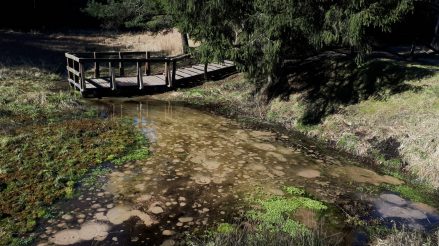
Svilė springs are an interesting and widely visited natural hydrological phenomenon. The springs found in an area of 1.8 ha, are the largest in Lithuania; over a hundred springs are flowing out of the ground here. Insects from the Ice Age – caddisflies – are found in the Svilė stream that flows out of these springs (one of a kind in Lithuania). According to local residents, there were more and bigger springs before the war. Sometimes the water would come out of the ground in fountains. As a result of land reclamation and other human activities, a large part of the spring area has become swampy. Today, the pulse of the springs is no more than three centimeters.
Our ancestors believed that spring water has special powers and helps to heal. Svilė springs are also considered magical. People often use their water not only for cooking but also for treating various diseases. An old legend talks about the “eyes” of the Svilė springs. A manor once stood on the site of the springs, which was ruled by a cruel lord. Once an old woman cursed the lord and he with the whole estate disappeared underground. And now he is still trying to dig himself out, that is why the water keeps bubbling…
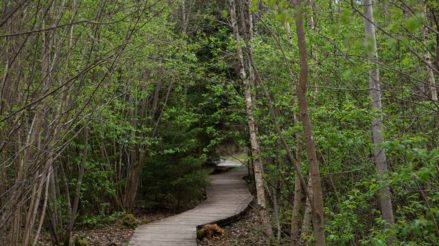
While taking the trail, you can admire the landscape of the Vainagiai Reserve and visit the Vainagiai Mound. An observation tower which offers a view of the beaver settlement and the dam built by them has been built right next to the trail. While traveling around Lake Vainagiai, you will get to know various forest plants, forest cuttings, key forest habitats and many other objects.
The size of Lake Vainagiai is 9 ha, the average depth is 3 meters, the lake has no tributaries, the lake fills up from precipitation and springs. The Juodupis stream flows out of the lake, and you will be able to cross it using a wooden bridge. You will also learn about the moss, will be able to admire the heathers, learn about the key habitats and visit the high marsh.

The residents of Gailiškė village have been passing down the story from generation to generation about Napoleon’s gold that was buried by the old pine during the retreat of the French army. Over the years, the legend about the treasure has been embellished with various miracles. It was said that the spot near the tree is haunted.
Multiple-stemmed trees have always attracted people’s attention. In ancient times, the number three was believed to be magical. It is associated with cosmogonic images of the world and its division into three levels: upper (sky and birds), middle (earth, people and animals) and underground (darkness, water and snakes). This world model was later adopted by Christianity (heaven-earth-hell).
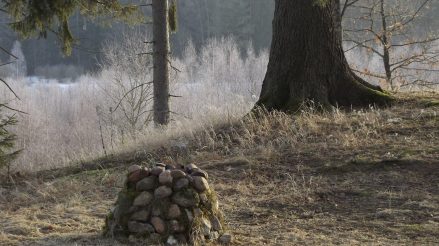
Vainagiai Mound, also called Piliukas, is located in the Kelmė district municipality near the village of Vainagiai. The mound was built on a separate hill, surrounded by marshes on all sides. The plot is oval, elongated, stretching from east to west. Its size is 45×22 m, one meter deep in the middle and a with wider western end. On the north-western slope, 1 m below the site, there is a 10 m wide terrace, descending to the west over 1 m. The slopes are steep, 14 m high.
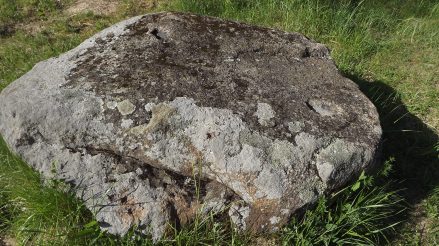
There are several indentations on this stone that resemble a child’s foot. People used to say that they were left in the stone by an ascending baby Jesus or a descending angel. During the installation of the Ribiškiai pond, the stone was removed. In 2008, on the initiative of the Kurtuvėnai community, the stone with the “God’s footprint” was brought back and placed at the foot of Rimas Hill, not far from the place it was originally found.

Church was built at the expense of Jurgis Gruževskis, an elder from Žemaitija in 1615. The architecture of the building is a mix of gothic and Renaissance styles. The church has one nave, one tower, a Gothic three-walled apse, and Gothic windows. One of the most important issues in Reformed doctrine is the issue of justification. The Reformed believe that man receives salvation through God’s grace. Sola Gratia – “grace alone” – is the core of the Reformed faith. However, it is not only the forgiveness of sins granted by God, but also the rebirth of the person. A man cannot earn salvation by his own efforts, without God’s justifying grace.

The chapel is located in the Dubysa valley, on the Kelmė-Tytuvėnai road, two kilometers from Maironiai church. There is a big stone under the chapel. On it, according to the old people, there is an imprint of a child’s foot, a cane and a knee. Inside the chapel there is an altar with the statue of Virgin Mery. The crosses that stand around the chapel symbolize the gratitude for God’s graces that were received here.
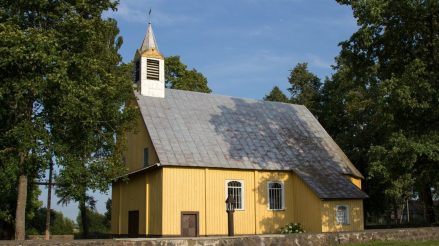
The first chapel in Maironiai was built by Juozas Stankevičius, a landowner from Saudininkai in 1782. In 1817 the chapel became a branch of Lyduvėnai parish. The village that appeared on the land of Saudininkai Manor in 1927 received a name of Maironiai.
The church is built in the style of folk architecture, it has a rectangular plan, a three-walled apse, and a tower. There are three altars and an 18th century painting of Three Wise Men and above it hangs a painting of a praying – and illuminated by the light of God’s grace – St. Isidore the patron saint of farmers. Instead of him, an angel is ploughing the land.

The late Baroque church was built in 1764. During the Second World War, the church was badly damaged, but it was repaired in the post-war years. Above the presbytery, in the church, there is an impressive image of the Virgin Mary waiting for the Holy Spirit together with the apostles. The Lord granted grace and sent us the Holy Spirit. In commemoration of that event, we celebrate Pentecost.

This is one of the former buildings of the Katauskiai Manor homestead. The chapel was built in 1835 and restored in 2008 to mark the 400th anniversary of the apparition of the Virgin Mary in Šiluva.
Lithuanian manor chapels were small and mostly intended for the needs of the landlord’s family. The landowners believed that God’s grace could visit their family if a chapel stood on their land.
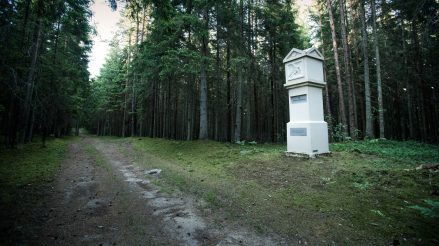
They were built in 2013. In total, 14 roadside poles with statuettes of saints, marking the stations of the cross, were built in Šiluva pinewood. Stations of the Cross are most suitable for pilgrims traveling from the Raseiniai side. The length of the road through Šiluva pinewood to the Chapel of the Apparition is 2.5 km. Through the Station of the Cross prayers people ask for the Lord’s graces, the forgiveness of sins, and peace.

The first Catholic church in Šiluva was built in 1457. Later, the Calvinists prevailed but the apparition of the Virgin Mary in 1608 and the events that followed, when documents of the Catholic Church and a miraculous painting were found in a chest buried in the ground, helped the Catholics to reclaim the land. The icon of Our Lady of Šiluva painted in the beginning of the 17th century, and famous for its miracles, can be found in the high altar of the church. It was granted a Canonical coronation in 1786 and is still famous for its graces as evidenced by the numerous votive offerings hanging nearby. The red brick church was built in 1786. The space between the church and chapel was renovated in 2008 and a monument to John Paul II was erected.
For a long time, a wooden chapel stood at the place of the apparition of the Virgin Mary. The brick chapel was designed for the 300th anniversary of the apparition of the Virgin Mary in Šiluva (architect A. Vivulskis). The cornerstone was consecrated by priest and poet Maironis in 1912. The chapel, which is 44 meters tall, was finished in 1924. Inside it, the altar was built on the stone of the Apparition with a sculpture of the Virgin Mary above.

The Road of the Mysteries of the Rosary of the Blessed Virgin Mary with 20 stations is set up on a segment of Raseiniai – Šiluva road. This Road of the Mysteries of the Rosary project started in 2012 and was dedicated to the 600th anniversary of the baptism of Žemaitija in 2013. About 30 wooden crosses and roadside poles with statuettes of saints were built during a plein air between Raseiniai and Šiluva. Wayside shrines depicting specific scenes dedicated to the Mysteries of the Rosary of the Blessed Virgin Mary were added to the existing wooden crosses in 2017.
They form the stations of Joy, Light, Passion, and Honor of the rosary. The final stop of the Mysteries of the Rosary Road is the Virgin Mary’s apparition place in Šiluva. While saying the rosary, we meditate on the mysteries and pray for God’s help to follow what they teach and win the grace of the Lord. Traveling along this road, you will also reach the church of the Assumption of the Blessed Virgin Mary in Raseiniai, where the relics of Teofilius Matulionis are guarded.
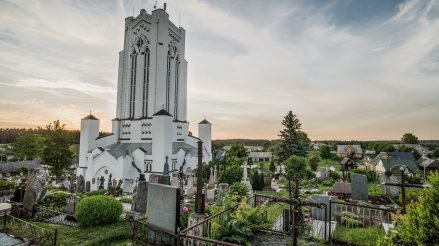
For a long time, a wooden chapel stood at the place of the apparition of the Virgin Mary. The brick chapel was designed to mark the anniversary of the apparition of the Virgin Mary in Šiluva (architect A. Vivulskis). The cornerstone was consecrated by the priest and poet Maironis in 1912. The construction of the chapel was completed in 1924; its height was 44 m. Inside it, an altar was built on the stone of the Apparition, and above it, a sculpture of the Virgin Mary. All the places of the Virgin Mary’s apparition bring hope, renewal, and the graces of God.
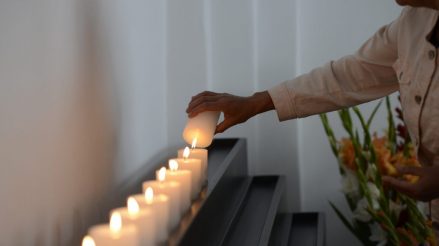
It was built behind the Chapel of Apparition in 2019. Candles of intention can be lit here. You can purchase them at the Pilgrim Information Center. Candles have four intentions: “Health for the sick, pray for us”, when people ask for health, physical and mental healing, and other favors; “God, I thank You”, when people thank for the graces granted; “Jesus, I trust You”, when people express trust in Jesus in various life situations; “Accept me into the Kingdom of Heaven”, when people pray for the dead.
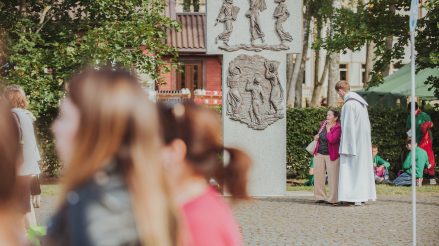
The stations of the Mysteries of the Rosary are placed around the sacred square. They are forged from stone, each 3.5 m high, 1 m wide and 0.5 m thick. A bronze bas-relief of each mystery is built in the center, near the cross-shaped chapel. Their author is sculptor Erikas Daugulis. The stations of the Mysteries of the Rosary help the pilgrims. The Rosary prayer procession moves from the Chapel of Apparition to the Basilica both during the church festivals and upon personal visits. The prayer of the rosary is a way to open our hearts to faith and joy and express our gratitude for the graces received.
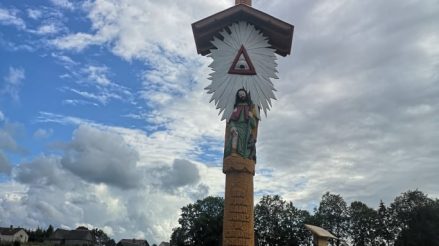
On the road to the Šiluva church (from the Tytuvėnai side) you will find a double-armed cross, also called the cross of Caravaca de la Cruz. The name is derived from the town of Caravaca in Spain. It is believed that God protects the area where such a cross stands from great calamities – plague, epidemics, other contagious diseases, or storms. Believing in God’s grace and protection, such crosses were usually erected on roadsides, crossroads, heights, churchyards or near homesteads. The author of the cross is woodcarver and sculptor Adolfas Teresius.

There is a hill called St. George’s Hill at the intersection of Skogalio and Šiluvos streets. It is believed that a wooden church stood here before the brick Bernadine church of Tytuvėnai was built here. Traces of foundations remain as well as several stones that suggest there once was a cemetery here.
St. Geroge Hill is an important place in the history of the region, marking the way to other places in Tytuvėnai famous for their graces.

After the uprising of 1863 – 1864, when the Catholic church that wasn’t closed, successfully survived, there was a plan to build a separate orthodox church for the Orthodox Christians, who were brought here by tsarist authorities. A. Christianovičius built a temporary church in Tytuvėnai in 1872 on his estate and the new brick Orthodox church was built in 1873 – 1875. The parish was cared for by the priests from Raseiniai and Kolainiai. The Soviet authorities sought to close this church. They wanted to turn it into a warehouse in 1947 and in 1953 they ordered to pay the debts, which the clergy were able to cover. Currently, the church is a branch of the Church of the Apostles Peter and Paul in Šiauliai. The Orthodox believe that the grace of the Holy Spirit is achieved through prayer, asceticism and intense efforts of the will.

Tytuvėnai church of the Blessed Virgin Mary the Queen of Angels and the Bernardine monastery complex is the largest and one of the most interesting sacral architecture complexes of the 17th – 18th centuries, characterized by a variety of architectural styles. Tytuvėnai church contains a miraculous painting of the Madonna and Child and there is a unique chapel of the Holy Stairs in the churchyard. The Madonna and Child painting famous for its graces was painted in the 1720s. It is the ornament of the whole church. The child is blessing with his right hand and the Virgin Mary’s right hand is directed at Him – the source of graces.
The monastery complex was finally formed in 1772 – 1780. A closed rectangular courtyard with arcaded galleries for Stations of the Cross was built next to the church. The church also has a relic of Pope John Paul II – a drop of blood placed in a special capsule.

The chapel was built in 1853 by J. Pšeciševskis in memory of his deceased wife Celina. The walls, windows, and cornices of the chapel are decorated, and doors and windows are of the Gothic style. The landowners of Tytuvėnai and Pagryžuvis manors and their relatives are buried in the crypts of the chapel. The chapel is named after Christ the Saviour.
The only way to receive graces is to personally accept Christ as Saviour.

The first chapel in Kiaunoriai was built in the 18th century. The church was repeatedly demolished, burned, and rebuilt. The current church was built in 1991. At the gate of the churchyard stands the state protected Kiaunoriai oak. Kiaunoriai residents ask for God’s grace, to receive funding that would allow them to complete the construction of the belfry next to the church.

The first church in Basilionai was built in 1749. Until 1836, there was a monastery of Basilian monks here. The current wooden church was built in 1933. The building is an example of folk architecture with rich interior. The church is famous for the sculpture of St. John of Nepomuk, which was stolen, but thanks to the grace of God returned to the church.
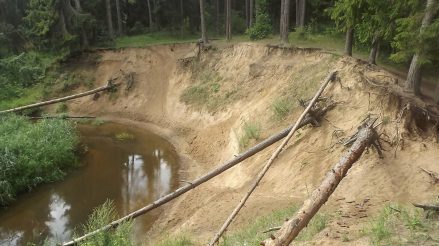
Dengtiltis outcrop opens on the right bank of the Dubysa bend. Its length is about 100 m, its height is up to 8 m. The outcrop shows the layers of sand and other sediments that formed when the glacier was melting.

In the upper reaches of Dubysa, the building of water mills started after the uprising of 1831, after the construction of Venta – Dubysa overpass failed. The energy generated by the river in these surroundings in the end of the 19th century was used by Dengtiltis, Mirsiškė, Bernotai and Burkšiai mills and Bubiai sawmill.
In the same place where the Dengtiltis mill stands now, a bridge with a thatched roof was built across Dubysa in the 19th century. People say that it inspired the name of the settlement.
Until 1863, Dengtiltis mill belonged to Pašiaušės landowner Vincentas Vitkevičius. He was exiled to Siberia for his participation in the uprising. The tsarist authorities confiscated the Pašiausė estate and gave it to General Bukshevden. People did not like the new owners of the manor, they called them “shit counts”. The Bukshevdens had a hard time farming, so in the end of 19th century, they sold the estate. A Latvian man under the name of Insterburg, who bought the farm, started to transform the place rebuilding the mill as well.
After the nationalization (1940), the Dengtiltis mill was handed over to the Šiauliai Industrial Combine, later it went to a collective farm. Today, it is again privately owned and is being gradually maintained and reconstructed.
The mill is privately owned. Visiting inside is not allowed. The outside can be viewed at any time.
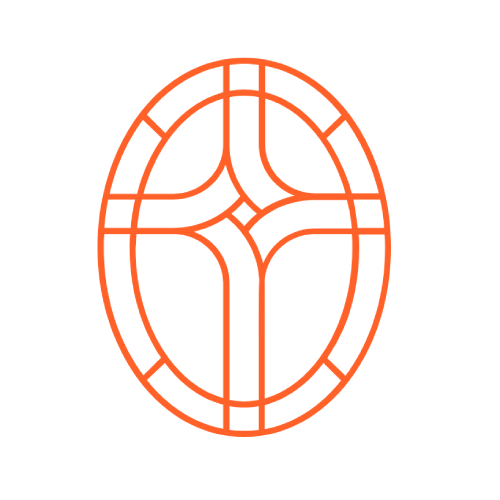
The ancient fortification of Pašimšė is called Skambalas Hill. It is a regular quadrangular hill topped by a 50 m long and 16 m wide site. The slopes of the hill are 6.5 m high, regular, steep, with terraces on three sides: 6 m in the northeast, 1.5 m in width on the northwest slope; on the south-eastern slope, 1.5 m below the site, there is a 1.8 m wide terrace, 1.3 m below it there is a second 1.5 m wide one and 1.6 m, below a third 2 m wide terrace. There are none at the southwestern end, and a road has been made here to drive up the hill. In 1967 the hill was surveyed by the Institute of Lithuanian History. Most likely, it was created by a landowner. The ancient fortification of Pašimšė landscape and archaeological monument protected by the state.
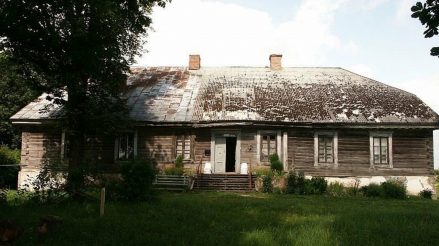
Kiaunoriai Manor is a former manor homestead in Kiaunoriai, Kelmė district. The wooden manor house built in 1851 (walls made of logs, covered with boards, carved window frames) has remained along with the clay-moulded granary built at the end of the 19th century.
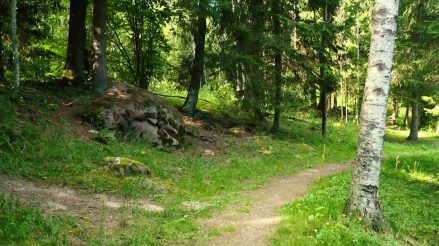
The stone strips in Lithuania can only be found in Tytuvėnai Regional Park and north of the park, towards Šiauliai. While walking along the trail, we can have a better view of the strips admire individual stones and boulders. Along the trail, visitors will see copies of various mythological stones, stone sculptures made by different artists and will and learn about how people use stones in various fields. The educational stands provide information about the emergence of stones, their types, the ice age and the formation of the stone path. The unique paths of stones in these forests – which have been called rūža since the olden days – are stone embankments formed during the last ice age.
Only the backs of individual boulders stick out, and in many places the terrain descends to one side, in some places even by 2 meters. After digging into the earth’s surface between the protruding boulders, you will bump into 1-2-meter-wide strips of stones. There are four of such types of stone strips in the Užpelkiai forest. Two of them have been studied by geologists and have been given the status of a natural heritage object. These are the Tučkinė stone stretch and Velniakelis. The end of the stone strip, where it forms a tight loop, is very expressive. Long time ago, a homestead stood in it with a farming patch. Behind the strip the terrain descends in all directions. It is shaped like an island in a humid forest, surrounded by a stone embankment. Very old trees grow on the homestead, and a cosy rest stop was installed for hikers.
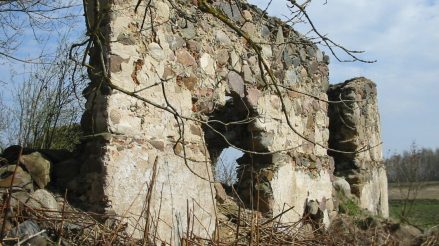
Tytuvėnai Manor is mentioned in written sources of 1500. It was owned by the famous noblemen of the Grand Duchy of Lithuania: Sapiega, Valavičius, Radvila. Manor buildings did not survive, only the manor grounds remain including ponds, garden, alleys, and the remains of buildings. At the beginning of the 20th century, the bright and talented people Sofija and Eugenijus Romeris became the owners of the Tytuvėnai Manor and the part of the town. Until the crucial year of 1941, it was this family’s home, where Sofija created and raised 5 children. The house was built of larch logs and covered with wooden shingles. The manor had a water mill, a sawmill, a weaving company, greenhouses, a building for fruit drying, and a forge. It was not only a very well-run farm, but also a famous place that attracted people of culture and art. Maironis used to visit the manor. He also spent the last summer of his life here.
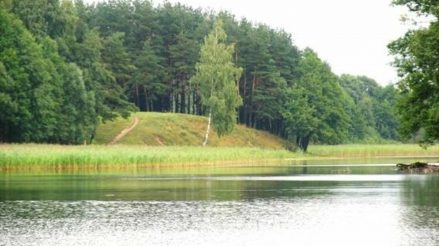
The mound is located on the former island of the lake, the western part of a separate hill located on the northern shore of Lake Bridvaišis. It was protected by a swamp – which is a peat bog now – from all other sides. The plot is quadrangular, elongated in the north-south direction, 25×18 m in size. A 0.3 m high, 5 m wide embankment was created on its eastern side, behind which an 8 m wide, 0.2 m deep ditch was dug. Slopes are moderately steep, 1.5 –6 m high. The southern slope of the mound is washed by Lake Bridvaišis. The slopes are covered with pine trees, the site lies fallow.
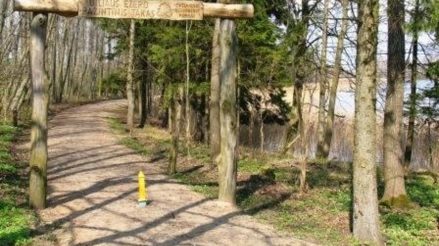
Gilius is one of the four larger lakes surrounding the city of Tytuvėnai, distinguished by its special colour and great diversity of flora and fauna. The area of the lake is 36 ha, and the deepest point reaches as much as 23.1 m. Legend has it that the lake flew in with a tornado and fell down on the forest that grew here. The emerald green of the water comes from the springs that feed the lake. Their water is saturated with dissolved carbonates that come from the depths of the earth. The green colour of the water is accentuated by the reflection of the lake environment in the water and the green weeds growing in its depths. The lake was formed 10 – 14 thousand years ago as the glaciers melted.
At the current location of the lake, a massive block of ice stood, which, over time got covered up with soil and finally melted when the climate warmed up completely. The water from the melted glacier remained in the ravine formed by it. You will be able to learn about the natural treasures of the lake by traveling along the 3.3 km long educational trail that leads along the constantly changing shore of the lake.

From the 15 m high tower (also called Kokmaniškė or Majakas) an impressive landscape of Tytuvėnai surroundings opens up. You can see Pašakarnia pond, the manor park, the forests of the Gomerta landscape reserve, and if you look closely, you can see Šiluva church in the distance.

Tytuvėnai cemetery chapel is one of several chapels located in Tytuvėnai borough, Kelmė district. The chapel stands in the Catholic cemetery, on its northeastern edge, on the axis of the central path. Nearby, 250 m to the west of this chapel (behind the cemetery area), you will find Riomeris mausoleum-chapel.
The Catholic cemetery is the largest in the town. The cemetery chapel was built by the local resident Juozapas Kaminskas. It is a quadrangular building, 7.5×8.5 m in size, 9 m high, made of stone and covered with tin-plate. Kaminskas family is buried there. The year 1827 is carved into the foundation stone of the front wall (to the right from the entrance).

The exhibition in the visitor center of the Tytuvėnai Regional Park briefly presents the most interesting objects of natural, historical and cultural heritage located in the territory of the park. Here, as if from the flying crane’s bird’s-eye view of the stands, you can see the sprawling Tyrelis swamps, the chain of lakes Apušis, Gilius an Bridvaišis, the Curonian burial mounds and Kudinai and Bridvaišis mounds, fragments of manor homesteads, sections of stones and abundance of sacred and historical places. You can get closer to ancient times by examining archaeological finds, see how melting glaciers shaped the terrain and rare natural formations of this region, learn about the famous uprising of 1831 and the crucial uprising of 1863.
Lunch break 12 a.m. – 12:45 a.m.

The thick pine of Tytuvėnai pinewood is a botanical natural heritage object. It grows in the Tytuvėnai eldership, Kelmė district, on the territory of the Tytuvėnai forestry (32 sq. 35th lot), Tytuvėnai forest, near the regional road Tytuvėnai – Pakapė – Šiauliai. The tree falls within the territory of the Tytuvėnai Regional Park. It received protection in 2005. The type of the tree is Scots pine (Pinus sylvestris L.). The girth of the tree trunk at a height of 1.3 meters is 340 cm, the height is 28.5 m, the height of the crown is 12.5 m, the width of the crown is 14 m. It has three tops and is about 220 years old.

On the right bank of the Gryžuva river stands the Pagryžuvys Manor of romantic architecture. The palace was built in 1858 according to the design of the famous architect of that time, F. Rimgaila. At the end of the 18th century, Pagryžuvys Manor belonged to the noble family of Šemeta and later to the family of Pšeciševskis. After World War I, the manor was nationalized and given to the Jesuits. In addition, the estate was heavily damaged, since it had found itself on the front line during the war. Until World War II, the palace housed a Jesuit monastery and a care home.
Pagryžuvys Mound is located on the left bank of Gryžuva. From the north, northwest and east, it is surrounded by the Gryžuva river and its valley. From the south, there is an adjacent hill. The slopes are steep, 12 – 13 m high. The plot has an irregular oval shape, elongated in the north-south direction, 11 m wide, 18 m long (it used to be round). The eastern part of the site and the northern slope were washed away by the Gryžuva. The mound is overgrown with deciduous trees, the underwood is cut down, and the site lies fallow. At the southwestern foot of the mound, there is a settlement on an area of 1 ha.
The manor is private, visiting inside is not possible. Viewing the manor from the outside and visiting the mound is allowed at any time.
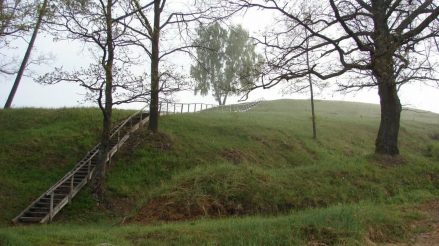
The mound (Birutkalnis) is built on the protuberance of the bank, on the left bank of Dubysa and on the right bank of Gryžuva, at the confluence of these rivers. It dates back to the end of the 1st millennium and early second millennium.
The site is quadrangular, elongated, stretching from south to north, 78×43 m in size, surrounded by a 15 m wide embankment up to 1 m high. 2 m below its northwestern corner there is a 0.5 m wide terrace, and another 2 m below there is a second 12 m wide terrace. The slopes are steep, up to 24 m high. The mound was destroyed by ploughing, the first terrace by trenches, and the western slope by the road that cut into it. The mound lies fallow, its slopes are covered with deciduous trees, which have been cut down considerably. The mound is also known as Papušynio. At the foot of the western part, there is a settlement in an area of 0.5 ha.
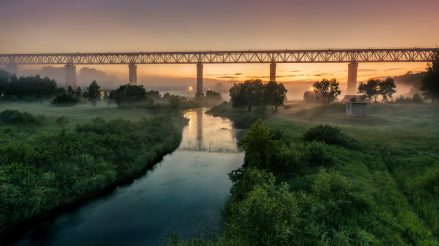
It is the longest and tallest bridge in Lithuania, extending 599 m and rising as much as 42 m above the impressive valley of the Dubysa River in the Dubysa Regional Park. The first bridge, built in 1916, was wooden. The current bridge was built in 1951.It is not possible to climb on the bridge.
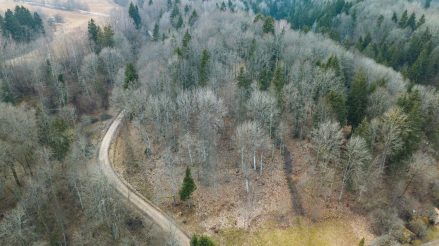
You will see one of the three mounds – also called Danutė Hill – 350 meters southwest of the famous Lyduvėnai bridge. The mound is fortified with ramparts and ditches. Now it is overgrown with forest and after you climb on top, you can see the panorama of Lyduvėnai bridge. Danutė, the duchess of the castle, became very sad when she sent her lover off to war and he did not return. This is where the name of the area – Liūdžiuvėnai, Liūdavėnai, Lyduvėnai (liūdėti is to be sad in Lithuanian) – came from.
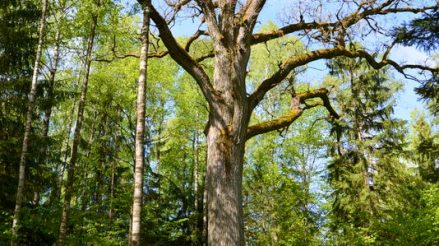
Natural heritage object protected by the state since 1960. You can reach it via educational, 350-meter-long educational wooden trail. This oak has impressive dimensions: 1.76 m in diameter, 5.6 m in girth, and 32 m in height, and it is estimated that the tree is about 300 years old. You will find an equipped rest area next to the educational trail.

A museum has been set up in Maironis’ hometown of Bernotai, at his sister’s house. The homestead has an old garden, an icehouse, a barn, and a hay barn. The remaining stones mark the site of the old homestead of Maironis’ parents. The museum exhibits authentic items of the Maironis family, characteristic of everyday life then.
There is an installation titled Maironis’ Parents’ House in Bernotai. A visualization “melting” in the space that replicates the building was created along with an installation Singing Bench.
Working hours on the last Sunday of every month 11 a.m. – 3 p.m.

The park management moved to the new visitor center in the village of Kaulakiai in 2020. The center’s exposition that introduces visitors to the park uses Maironis’ poems. The poet’s narrative is continued in the educational trail – Maironis’ Path along Padubysys – created by the Dubysa Regional Park and beloved by the visitors.
Lunch break 12 p.m. – 12:45 p.m.

Maironis’ Path along Padubysys educational trail created by Dubysa Regional Park and beloved by visitors stretches through the naturally valuable areas of the Dubysa Regional Park in which you will find information stands, resting spots, footbridges across Luknė and Lelykas streams. A small wooden observation tower was built near Luknė valley. The route is not circular and extends 13 km from Dubysa Regional Park visitor center in Kaulaliai to Betygala. Suitable for pedestrians and cyclists at any time of the year.
IMPORTANT!
When traveling on this route:

It is a natural monument protected by the state. Its length is 4.6 m, and its height is 2.43 m. In pre-Christian times, the holy fire was burning on it and now a chapel stands there. Legend has it that the stone has healing powers and a treasure hidden beneath it. Until the 1930s, the place was very popular. People prayed and vows were made next to the chapel.
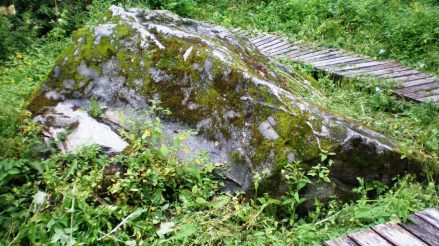
There are several state-protected boulders in the Raseiniai district, one of them is Žalpių stone, also known as a stone with a flat-bottomed bowl. Legend has it that God and the Devil once sat together on this stone, and this is how footprints appeared on the stone. The devil accidentally fell and got so angry that he kicked the stone into a corner.

The first church in Basilionai was built in 1749. Until 1836, there was a monastery of Basilian monks here. The current wooden church was built in 1933. The building is an example of folk architecture with rich interior. The church is famous for the sculpture of St. John of Nepomuk, which was stolen, but thanks to the grace of God returned to the church.
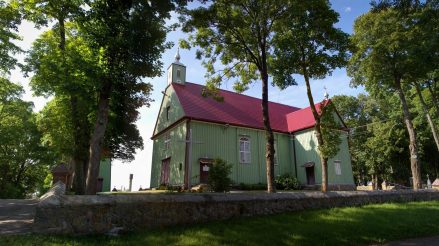
In 1860, the owner of Pakapė Manor Eustachijus Karpis built a wooden church. A new church was built in 1879, which has remained almost unchanged to this day. It is one of the few churches in Lithuania that is painted green. The green color in the Church liturgy symbolizes the hope of eternal life and salvation – the pursuit of God’s grace.

The church was built as the chapel of Karpis Manor in 1800 and received the status of a church in 1936. Around 1956 the church was closed, its property looted. It was turned into a warehouse. By God’s grace, the church was returned to the faithful in 1989, and in 1991 it was consecrated again.

It is an ancient holy site located at the confluence of the Šetupis and Žiedupis streams. A ceremonial stone with a bowl-shaped dimple can be found on the hillside. The legend has it that there used to be a church on the hill, but it was swallowed by the earth.

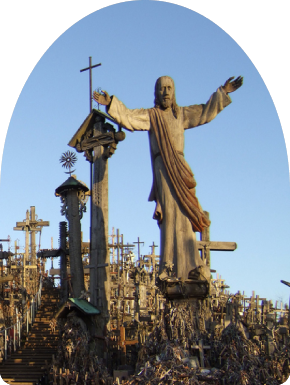
The Hill of Crosses – which is one of its kind in the world – is located 12 km north of Šiauliai. It is believed that in the Middle Ages, a wooden castle – referred to as Kula in the chronicles – stood on this hill and was destroyed by the Livonian army in 1348. Locals said that the first crosses were erected in the mid-19th century, praying for God’s grace and health, because people considered this hill to be a sacred place. Others said that the crosses were erected to commemorate those who died in the uprisings against tsarist Russia in 1831 and 1863.
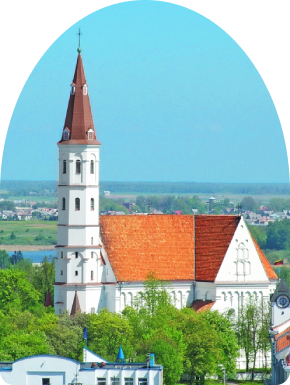
The steeple (70 meters tall) of the renaissance cathedral built in the 17th century is visible from all main roads. The diocese of Šiauliai was established there by decision of Pope John Paul II on May 8, 1997. The church became the Cathedral of St. Apostles Peter and Paul. One of the oldest sundials in Lithuania has survived on the wall of the southern facade of the cathedral. The cathedral contains two images of the Virgin Mary – next to them there are votive offerings – famous for their graces. At the cathedral’s mother of God’s chapel people say litanies or recite the rosary and in the chapel of Divine Mercy they recite the Chaplet of the Divine Mercy.
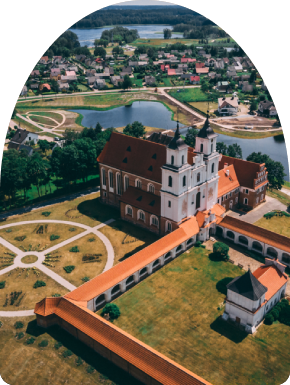
Tytuvėnai church of the Blessed Virgin Mary the Queen of Angels and the Bernardine monastery complex is the largest and one of the most interesting sacral architecture complexes of 17th –18th centuries, characterized by a variety of architectural styles. Tytuvėnai church contains a miraculous painting of Madonna and Child and there is a unique chapel of the Holy Stairs in the churchyard. The Madonna and Child painting famous for its graces was painted in 1720s. It is the ornament of the whole church. The child is blessing with his right hand and the Virgin Mary’s right hand is directed at Him – the source of graces.
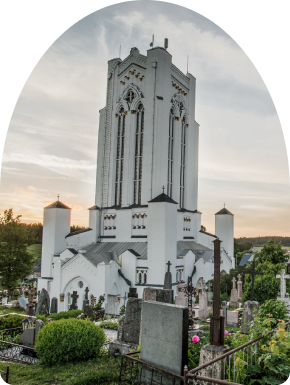
The first Catholic church in Šiluva was built in 1457. Later, the Calvinists prevailed but the apparition of the Virgin Mary in 1608 and the events that followed, when documents of the Catholic Church and a miraculous painting were found in a chest buried in the ground, helped the Catholics to reclaim the land. The icon of Our Lady of Šiluva painted in the beginning of the 17th century, and famous for its miracles, can be found in the high altar of the church. It was granted a Canonical coronation in 1786 and is still famous for its graces as evidenced by the numerous votive offerings hanging nearby. The red brick church was built in 1786. The space between the church and chapel was renovated in 2008 and a monument to John Paul II was erected.
The path is circular. You can start and end the trip at the same point or anywhere else on the route. The trip can be divided into parts or completed at a time.
You can travel on foot (7-8 days), by bicycle (3-4 days) or by car (2-3 days).
.
The length of the pedestrian and bicycle route is 185 km, when travelling by car, it is 190 km. The length of the day trip depends on the time spent travelling and the accommodation you choose.
We advise pilgrims to participate in the Holy Mass every day, to make a confession and to receive the sacrament of Holy Communion during the trip.